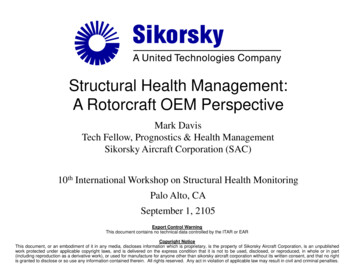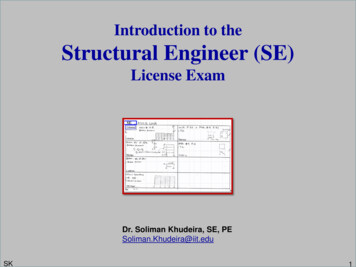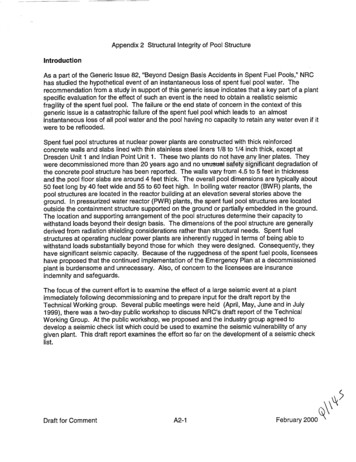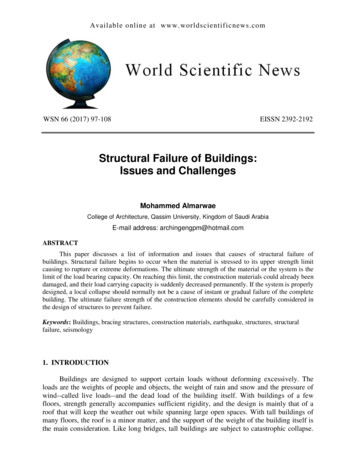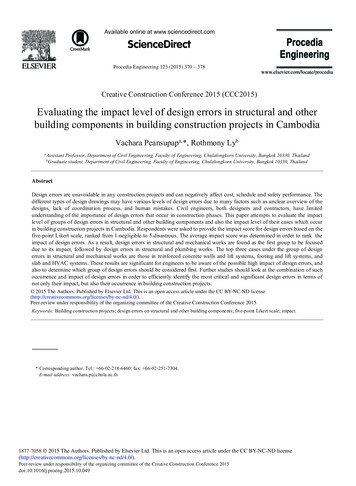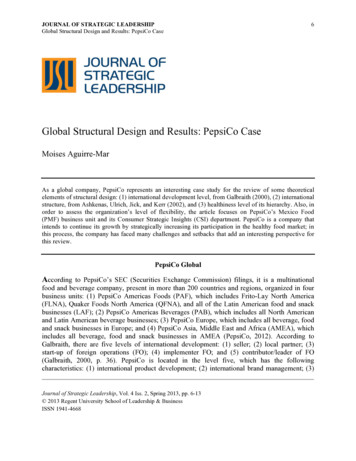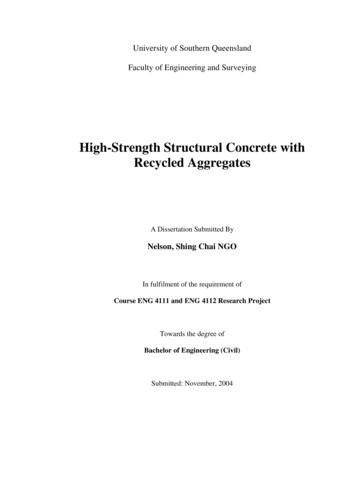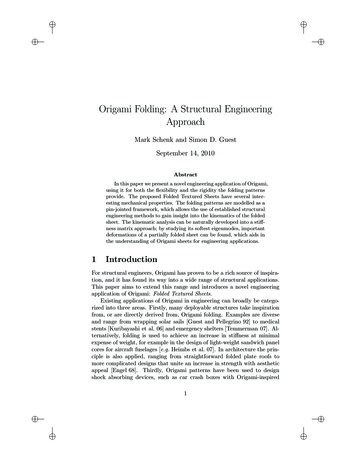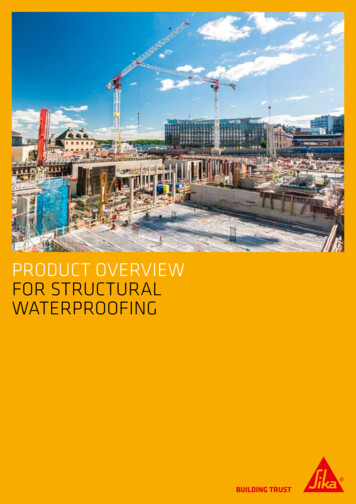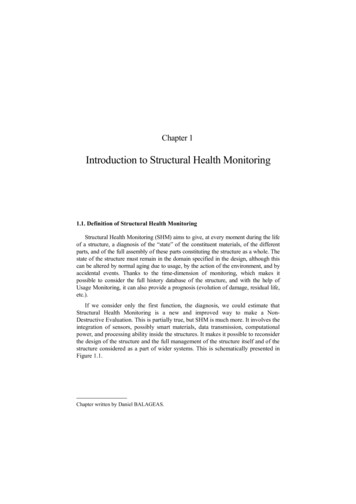
Transcription
Chapter 1Introduction to Structural Health Monitoring1.1. Definition of Structural Health MonitoringStructural Health Monitoring (SHM) aims to give, at every moment during the lifeof a structure, a diagnosis of the “state” of the constituent materials, of the differentparts, and of the full assembly of these parts constituting the structure as a whole. Thestate of the structure must remain in the domain specified in the design, although thiscan be altered by normal aging due to usage, by the action of the environment, and byaccidental events. Thanks to the time-dimension of monitoring, which makes itpossible to consider the full history database of the structure, and with the help ofUsage Monitoring, it can also provide a prognosis (evolution of damage, residual life,etc.).If we consider only the first function, the diagnosis, we could estimate thatStructural Health Monitoring is a new and improved way to make a NonDestructive Evaluation. This is partially true, but SHM is much more. It involves theintegration of sensors, possibly smart materials, data transmission, computationalpower, and processing ability inside the structures. It makes it possible to reconsiderthe design of the structure and the full management of the structure itself and of thestructure considered as a part of wider systems. This is schematically presented inFigure 1.1.Chapter written by Daniel BALAGEAS.
14Structural Health MonitoringMonitored physicalphenomenon, depending onthe damageIntegrity Monitoring system,defined by a sensed physicalphenomenon and an adapteddata reductionDamageSensorsSensorsmultiplexingfusionand lthMonitoringUsageMonitoringPrognosisMonitoring of usage conditionsData cumulativerecordingDamage andbehavior lawsHealth and UsageMonitoringMaintenance organizationHealth Managementof the structureHealth Managementof the full system (fleet, plant.)Figure 1.1. Principle and organization of a SHM systemIn Figure 1.1, the organization of a typical SHM system is given in detail. Thefirst part of the system, which corresponds to the structural integrity monitoringfunction, can be defined by: i) the type of physical phenomenon, closely related tothe damage, which is monitored by the sensor, ii) the type of physical phenomenonthat is used by the sensor to produce a signal (generally electric) sent to theacquisition and storage sub-system. Several sensors of the same type, constituting anetwork, can be multiplexed and their data merged with those from other types ofsensors. Possibly, other sensors, monitoring the environmental conditions, make itpossible to perform the usage monitoring function. The signal delivered by theintegrity monitoring sub-system, in parallel with the previously registered data, isused by the controller to create a diagnostic. Mixing the information of the integritymonitoring sub-system with that of the usage monitoring sub-system and with theknowledge based on damage mechanics and behavior laws makes it possible todetermine the prognosis (residual life) and the health management of the structure(organization of maintenance, repair operations, etc.). Finally, similar structuremanagement systems related to other structures which constitute a type of supersystem (a fleet of aircraft, a group of power stations, etc.) make possible the healthmanagement of the super system. Of course, workable systems can be set up even ifthey are not as comprehensive as described here.
Introduction to SHM151.2. Motivation for Structural Health MonitoringKnowing the integrity of in-service structures on a continuous real-time basis isa very important objective for manufacturers, end-users and maintenance teams. Ineffect, SHM:– allows an optimal use of the structure, a minimized downtime, and theavoidance of catastrophic failures,– gives the constructor an improvement in his products,– drastically changes the work organization of maintenance services: i) by aimingto replace scheduled and periodic maintenance inspection with performance-based (orcondition-based) maintenance (long term) or at least (short term) by reducing thepresent maintenance labor, in particular by avoiding dismounting parts where there isno hidden defect; ii) by drastically minimizing the human involvement, andconsequently reducing labor, downtime and human errors, and thus improving safetyand reliability. These drastic changes in maintenance philosophy are described inseveral recent papers, in particular for military air vehicles [DER 03], for Armysystems [WAL 03] for civil aircraft [BER 03, GOG 03], and for civil infrastructures[FRA 03].The improvement of safety seems to be a strong motivation, in particular aftersome spectacular accidents due to: i) unsatisfactory maintenance, for example, in theaeronautic field, the accident of Aloha Airlines [OTT 88] – see Figure 1.2a) – or, inthe civil engineering field, the collapse of the Mianus River bridge; ii) ill-controlledmanufacturing process, for example, the Injak bridge collapse (see Figure 1.2b)). Inboth fields the problem of aging structures was discovered and subsequent programswere established. To pinpoint the importance of the problem of structural aging, thefollowing statistic can be recalled: bridge inspection during the late 1980s revealedthat on the 576,000 US highway bridges, 236,000 were rated deficient by presentday standards [WAN 97].Nevertheless, analysis of the various causes of aircraft accidents points to therelatively low influence of maintenance deficiency. Figure 1.3 shows thatmaintenance is only responsible of 14% of hull loss. Furthermore, it should be notedthat only 4% of all accidents are due to structural weakness. It can be concludedthat, thanks to the introduction of SHM, even an improvement in maintenance and adecrease of structure-caused accidents by a factor of two would lead to a globalreduction of accidents of less than 10%, which is far from what is needed to avoid asignificant increase in the number of accidents in the near future if air trafficcontinues to increase.The economic motivation is stronger, principally for end-users. In effect, forstructures with SHM systems, the envisaged benefits are constant maintenance costsand reliability, instead of increasing maintenance costs and decreasing reliability forclassical structures without SHM (see Figure 1.4).
16Structural Health Monitoringa)b)Figure 1.2. Spectacular accidents have motivated the community to improve safety:a) the Aloha Airlines flight 243, April 29, 1988, due to corrosion insufficiently controlled bymaintenance; b) the Injaka bridge collapse, July 1998, due to a poorly controlledconstruction process
Introduction to SHM17Figure 1.3. Origin of hull losses: safety record for the worldwide commercial jet fleet, from[GOR 97]Structure QualityReliabilityCost of maintenanceStructure LifetimeStructure without SHMStructure with SHMFigure 1.4. Benefit of SHM for end-users [CHA 02]The economic impact of the introduction of SHM for aircraft is not easy toevaluate. It depends on the usage conditions and, furthermore, it is difficult toappreciate the impact on the fabrication cost of the structure. The cost of SHMsystems must not be so high as to cancel out the expected maintenance cost savings.
18Structural Health MonitoringIt is easier to evaluate the time saved by the new type of maintenance based on theintroduction of SHM. Such an evaluation can be found, for military aircraft, in[BAR 97], who reports that, for a modern fighter aircraft featuring both metal andcomposite structure, an estimated 40% or more can be saved on inspection timethrough the use of smart monitoring systems. Table 1.1 presents the figures resultingfrom this evaluation.Inspection typeCurrent inspectiontime (% of total)Estimated potentialfor smart systemsTime saved (% oftotal)Flight .5Service instructions370.6022.010044.0Table 1.1. Estimated time saved on inspection operations by the use of SHM, for modernfighter aircraft, from [BAR 97]Still in the aeronautic domain, there is also a benefit for constructors. Taking intoaccount the permanent presence of sensors at the design stage will permit a reductionin the safety margins in some critical areas. Weight reduction will be then possible,giving higher aircraft performance, lower fuel consumption and greater maximumrange.1.3. Structural Health Monitoring as a way of making materials and structuressmartSince the end of the 1980s, the concept of smart or intelligent materials andstructures has become more and more present in the minds of engineers. These newideas were particularly welcome in the fields of aerospace and civil engineering. Infact, the concept is presently one of the driving forces for innovation in all domains.The concept of Smart Materials/Structures (SMS) can be considered as a step inthe general evolution of man-made objects as shown in Figure 1.5. There is acontinuous trend from simple to complex in human production, starting from the useof homogeneous materials, supplied by nature and accepted with their naturalproperties, followed by multi-materials (in particular, composite materials) allowing us
Introduction to SHM19to create structures with properties adapted to specific uses. In fact, compositematerials and multi-materials are replacing homogeneous materials in more and morestructures. This is particularly true in the aeronautic domain. For instance, compositeparts are now currently used or envisaged for modern aircraft (see for instance inFigure 1.6, Boeing’s 7E7 Dreamliner project, which has 50% of its structures made ofcomposites). It is worth noting that this aircraft is the first one in which it is clearlyplanned to embed SHM systems, in particular systems for impact SmaterialsControllable materialsSensitivematerialsMULTIMATERIAUXMulti materialsNatural materialssimpleositecomp ialsrmateDetection, integratedcontrol, actionntDetection, externalige lsllcontrol, actioneint teria Detection, externalmacontrol, external actionDetectionProperties adaptedto predefined needsPropertiesa priori givenmaterials/structureswith health monitoringmaterials/structureswith shape or vibration controlFigure 1.5. General evolution of materials/structures used by people, and the place of smartstructures, including structures with SHMThe next step consists of making the properties of the materials and structuresadapt to changing environmental conditions. This requires making them sensitive,controllable and active. The various levels of such “intelligence” correspond to theexistence of one, two or all three qualities. Thus, sensitive, controllable and autoadaptive materials/structures can be distinguished. Classically, three types of SMSexist: SMS controlling their shape, SMS controlling their vibrations, and SMScontrolling their health. It is clear that materials and structures integrating SHMsystems belong, at least in the short term, to the less smart type of SMS. In effect,almost all achievements in this field are only intended to make materials/structuressensitive, by embedding sensors. The next step towards smarter structures would beto make self-repairing materials/structures, or at least materials/structures withembedded damage-mitigation properties. For damage mitigation, embeddingactuators made of shape memory alloys (SMA) could be a solution that would
20Structural Health Monitoringinduce strains in order to reduce the stresses in regions of strain concentration.These SMA actuators could be in the form of wires [YOS 96, CHO 99] or films[TAK 00]. As regards self-healing structures, very few attempts have been made.We could mention, in the field of civil engineering, the existence of self-healingconcretes containing hollow adhesive-filled brittle fibers: the adhesive is releasedwhen the fibers are broken in the region where cracking occurs [DRY 94]. A similarmethod can be applied to polymer matrix composites [DRY 96, MOT 99].CFRPCFRP sandwichGFRPAlAl, steel and Ti for the motor pylonsFigure 1.6. Example of the increasing importance of composites in civil aircraft: the 7E7Dreamliner has 50% of its structure made of composites. For this aircraft, impact detectionmonitoring systems are envisaged for outer panelsAs seen above, strong differences exist between structures with SHM and SMScontrolling their shape and vibrations. Nevertheless, it is interesting to considerthem as part of a whole (see Figure 1.7), since a really smart structure will integrateall three functionalities, and because they all rely on common basic researchesaimed at:– elaborating new sensitive materials to make sensors and actuators,– developing technologies to miniaturize sensors and actuators, and to embedthem without degradation of the host structures,– conceiving systems for data reduction and diagnostic formulation.This is the reason why, until recently, works on SHM were often presented atconferences and in journals devoted to the general topic of SMS.
Introduction to SHM21FullySmartStructuresDevelopment of systems for datareduction and diagnostic elaborationMiniaturization and embeddingtechnologies for sensors and actuatorsDevelopment of new sensitivematerials to make new sensors and actuatorsShape controlVibration ControlHealth MonitoringFigure 1.7. Common basis and complementarity of SHM, shape control and vibration control1.4. SHM and biomimeticsThe research on SMS in general, and on SHM in particular, is more or lessinfluenced by biomimetics (or bio inspiration). This attitude is a real source ofinnovation.Regarding SHM, a strong similarity exists between it and medical activity. Thishas been well pinpointed in [GAN 92] where a parallelism, given in Table 1.2, isdrawn.
22Structural Health MonitoringVery often, sensitive structures equipped with various types of sensors arecompared to living skin. This analogy remains superficial because skin is really anauto-adaptive smart structure controlling its integrity. This is possible thanks to thepresence of actuators that can counterbalance environmental aggressions. At themicro scale, the number and variety of skin sensors (see Figure 1.8) is way beyondwhat is possible with man-made sensitive structures (in one human hand there aremore than 100,000 sensors!). Finally, the reconstruction ability of living tissues iscertainly the most difficult function to reproduce.Phase of lifeManStructuresBirthBirth monitoringProcess monitoringSound lifeHealth check-upHealth and usagemonitoringIllness and deathClinical monitoringHealth (damage)monitoringTable 1.2. Parallelism between medical activities and SHM, from [GAN 92]Often, another analogy is also used, such as in [BER 03], between the nervoussystem of living beings and structures instrumented by sensors and equipped with acentral processor (see Figure 1.9). The gap between living systems and artefacts isperhaps smaller in this case and study of the functioning of the nervous system andthe brain is useful when conceiving control systems (adaptive control influenced bythe environment). After detection of the damage by the sensors embedded in thestructure, the central processor can build a diagnosis and a prognosis and decide ofthe actions to undertake (restriction of the operational domain to avoid overloadingin the damaged area, and/or scheduling a condition-based inspection possiblyfollowed by a repair).
Introduction to SHM23Figure 1.8. Sketch of human skin showing the variety of sensors and actuators making it areally smart structure, taken from [MON 74]Figure 1.9. Analogy between the nervous system of man and a structure with SHM,from [ROG 93]
24Structural Health MonitoringBiomimetics can help in finding new ideas, but we must avoid trying to copynature as closely as possible, since we do not use the same materials or the samefabrication processes. For example, bio-inspiration had a strong influence on thestrategy adopted by many researchers of supposing that it is mandatory to embed thesensors inside the materials of the structure. Such a choice is important since it hashuge consequences for the development of practical systems. The fully embeddedsolution considerably complicates the technology needed, creating problems ofdifferent kinds: higher miniaturization is needed, demonstration of theinnocuousness of the embedded sensor for the host structure has to be demonstrated,connectivities complicate the structure design and process, repair ability isproblematic, redundancy of sensor networks is needed, the operational life ofsensors must be at least as long as that of the structure, etc. The necessity forembedding the sensors is not obvious in most cases, and the drawbacks of surfacemounted sensors are often less critical than those of the more sophisticated solution.In such a case, this particular bio-inspiration could be a false “good idea”.1.5. Process and pre-usage monitoring as a part of SHMSensors for Health Monitoring can be incorporated into the components duringthe manufacturing process of the composite. Thus, in a global approach includingthe processing stage, the sensors can be used first of all to monitor the processingparameters in order to optimize the initial properties of the material. The physicalparameters of the material that can be monitored during the process are varied:refractive index, visco-elastic properties, conductivity, etc. A range of techniques isavailable allowing their on-line monitoring: electrical techniques [KRA 91, PIC 99],electro-mechanical impedance techniques using embedded piezo-patches [JAY 97,GIU 03], acousto-ultrasonics (or optical techniques using fiber-optic sensors [CHA01, DEG 02a]). It could be interesting to mix such different sensors achieving amultidetection [CHA 00].For temperature during the process and inside the composite, once again variousoptical fiber-based sensor systems are available. These are predominantly based onfluorescence decay measurements [LIU 00], fiber Bragg gratings [LIU 98, DEW 99]or modified extrinsic fiber Fabry–Perot sensors [DEG 02b].There is an intermediate phase of the life of a structure that can need SHM too:between the end of the manufacturing process and the beginning of the functioningphase, for certain structures, a lot of handling and transportation operations takeplace. During this phase, which could be called the pre-usage phase of the structure,accidental loads, not known by the end-user, may occur and threaten the structure’sreliability. A good illustration of such a risk is given in [GUN 99]. On January 17,1997, the Delta II mission 241 failed when the rocket exploded after a flight of 12.5
Introduction to SHM25seconds, with the consequence that the first of the new set of Global PositioningSatellites (GPS) was lost– see Figure 1.10. The occurrence of damage, caused by ahandling overload while the rocket was being transported by road before firing, wasstrongly suspected. The remedy consisted of equipping the structure with an SHMsystem that registered the shocks occurring during the full pre-usage phase.c)b)a)Figure 1.10. Delta II mission 241 explosion, from [GUN 99], a catastrophic failure which couldhave been avoided by pre-usage health monitoring – a) road transportation: the rocket is insidethe trailer, here detached; b) Delta II liftoff; c) the explosion, initiated from a crack in one of thegraphite epoxy motors situated at the base of the rocketFor this type of SHM, it is easier to detect the possible damaging events than thedamage that is thought to have been caused. The sensors can be resistive straingauges or strain-sensitive fiber-optic sensors for the quasi-static loads and acousticemission sensors for impact type loads.
26Structural Health Monitoring1.6. SHM as a part of system managementHealth Management can be defined as the process of making appropriatedecisions/recommendations about operation, mission and maintenan
aeronautic field, the accident of Aloha Airlines [OTT 88] – see Figure 1.2a) – or, in the civil engineering field, the collapse of the Mianus River bridge; ii) ill-controlled manufacturing process, for example, the Injak bridge collapse (see Figure 1.2b)). In both fields the problem o

